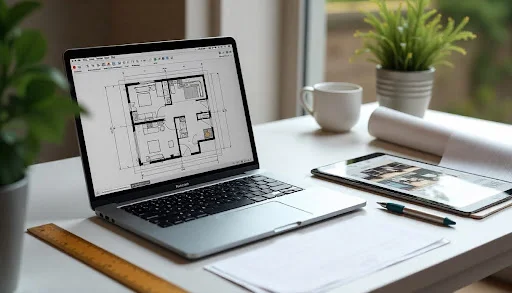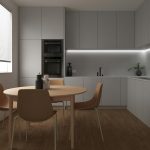Floor plan design isn’t just about drawing walls and doorways—it’s about shaping how people live, feel, and function in a space. With digital drafting tools and human-centered planning strategies, modern designers now create layouts that improve comfort, efficiency, and everyday experience.
Discover insights you can’t miss — dive into our related posts now!
Psychology of Space Planning
Before any wall is drawn or furniture is placed, professional designers begin with one core question:
“How will people move, behave, and live in this space?”
This approach is rooted in spatial psychology—the study of how the built environment affects human behavior. A well-strategized floor plan can promote smoother movement patterns, reduce stress, maximize functionality, and enhance comfort.
Flow and Circulation
Movement should feel natural—not forced. Good circulation minimizes conflict points (e.g., kitchen traffic bottlenecks or narrow entryways). Designers analyze expected human paths to ensure:
- Primary routes remain obstacle-free
- Door placements support intuitive travel
- Activity zones (eating, resting, cooking) are logically organized
Poor circulation can mentally fatigue occupants, especially in high-use environments like kitchens and hallways.
Zoning for Purpose and Privacy
Space is divided based on function:
| Zone Type | Examples | Purpose |
| Public | Living room, dining room | Social interaction |
| Semi-Private | Kitchen, study, playroom | Controlled social space |
| Private | Bedrooms, en-suites | Rest and withdrawal |
Zoning isn’t just logical—it’s emotional. Private areas should provide a sense of refuge, while public areas should feel open and inviting.
Light and Spatial Perception
Natural light influences mood, sleep cycles, and perception of space. Designers strategically position windows and apply layout principles like:
- Daylight Mapping: Planning interior zones based on natural light availability
- Reflective Surfaces: Using finishes and materials to maximize brightness
- Open-to-flow layouts: Allowing shared light between spaces
Virtual drafting tools now simulate light movement across hours and seasons, ensuring designs respond to real-world conditions.
Furniture Planning and Spatial Scale
Scale matters. Oversized furniture in a compact room can make it feel claustrophobic, while minimal furniture in large spaces can make them feel vacant. Digital planning software helps designers model accurate proportions—including functional typologies like Furniture Plan Drawing, which ensures spacing standards such as:
- Minimum 36 inches walking clearance
- 5-foot turning radius in accessible areas
- Standard seating radii for comfort and conversation
Why This Matters
People often respond emotionally to a space before logically analyzing it. A layout can feel “good” long before someone realizes why. With 64% of home buyers wanting to see floor plans before viewing a property, strategic planning isn’t just a design step—it’s a competitive advantage.
From Concept to Blueprint: The Evolution of Floor Planning
Floor plan design wasn’t always as streamlined and precise as it is today. Traditionally, architects and designers relied on manual drafting—a process requiring intense skill, time, and meticulous calculation. Every measurement, revision, and refinement had to be done by hand. While this method built some of the world’s greatest architectural landmarks, it left room for scaling errors, misinterpretations, and limited visual communication.
The move from traditional drafting to digital solutions marked a turning point in modern design. Early computer-aided drafting (CAD) software introduced accuracy, editable layers, and reliable scaling tools that drastically reduced human error. Instead of redrawing entire layouts after a small change, designers could now modify sections instantly—speeding up project development and improving collaboration.
As expectations in lifestyle design evolved, so did digital tools. Homeowners, builders, and real-estate buyers no longer wanted flat drawings—they wanted immersive experiences. Today, advanced drafting workflows allow designs to be tested against real-life behaviors, environmental conditions, and future needs long before the first brick is set.
Digital precision also influences decision-making. Because listings with floor plans receive up to 52% more engagement, design accuracy and visual communication have become part of the selling strategy—not just the planning stage. Whether creating a new build, remodeling an existing home, or marketing a property, floor plans now function as both a design asset and a communication tool.
This evolution didn’t just change architecture—it changed how people think about space. Instead of designing static structures, professionals now craft interactive living environments built around comfort, efficiency, and future adaptability.
Digital Drafting Tools Professionals Rely On
Modern drafting no longer depends solely on technical skill—it relies on software ecosystems that support accuracy, visualization, and collaboration. Today’s professionals use a combination of CAD (Computer-Aided Design) and BIM (Building Information Modeling) systems to transition from idea to executable construction documents.
CAD (Computer-Aided Design)
CAD tools help designers produce precise 2D and 3D drawings. They are commonly used for:
- Wall and structural layouts
- Elevation drawings
- Detail sections and dimensioning
- Early conceptual designs
CAD ensures millimeter-level accuracy, making it indispensable for architectural and interior planning.
BIM (Building Information Modeling)
While CAD focuses on geometry, BIM models represent data-rich, interconnected systems. A BIM model doesn’t just show walls—it knows what they’re made of, how they perform, and how they interact with mechanical, electrical, and plumbing systems.
Benefits of BIM include:
- Automatic updates across all plan views
- Materials, fixtures, and quantities generated directly from the model
- Construction simulations and cost forecasting
- Enhanced collaboration among builders, engineers, and designers
Studies show that integrating BIM can reduce planning time by up to 20% and material waste by about 15%, demonstrating how technology directly improves efficiency and sustainability.
Smart Visualization Tools
AR/VR tools allow designers and clients to:
- Walk through rooms virtually
- Test furniture placements
- Adjust lighting, finishes, and spatial boundaries in real time
This interactive approach bridges the gap between technical planning and user experience—making it easier to validate decisions before construction begins.
Human-Centered Design Principles
Modern floor planning isn’t just architectural — it’s behavioral. Human-centered design focuses on how people function within a space rather than how a space looks on paper. This approach prioritizes comfort, accessibility, and sensory experience, ensuring every structural decision enhances day-to-day living.
Designing for Behavior Patterns
Professionals often begin with behavioral mapping — observing how people cook, relax, socialize, or work. The insights gained help determine:
- Where storage should be placed
- How far appliances should be from prep areas
- Whether the home should encourage open gatherings or privacy
For example, a kitchen island isn’t just a design trend — it’s a hub for interaction and workflow efficiency in family-centered living.
Ergonomics and Spatial Comfort
Ergonomics ensures that movement feels natural and comfortable. Standard guidelines include:
- Counter height: 34–36 inches
- Doorway accessibility: minimum 32 inches
- Workspace walkways: 42–48 inches in kitchens
These aren’t arbitrary measurements — they come from studies on posture, reach, movement, and safety.
Universal and Inclusive Design
Inclusive spaces accommodate diverse needs: children, seniors, guests, and individuals with mobility or sensory differences. Universal design features may include:
- Step-free pathways
- Wider hallways
- Adjustable-height fixtures
- Lever-style knobs instead of traditional turning handles
A universally accessible home is more comfortable for everyone — not just those with specific needs.
Emotional and Cognitive Impact
Even subtle design decisions influence mood and productivity:
- Rounded layouts can feel more welcoming than sharp linear divisions
- Dedicated quiet zones help cognitive recovery
- Material acoustics reduce stress in busy households
Human-centered design transforms a house from simply functional to empathetic.
Creating Better Living Experiences Through Digital Testing
The advantage of digital planning is that designers no longer need to rely on assumptions — they can test environments before they exist. This forward-thinking approach improves efficiency, reduces costly revisions, and produces layouts aligned with real-world use.
Virtual Simulations and Walk-Throughs
Virtual Reality (VR) and Augmented Reality (AR) environments let users explore a space as if it were already built. They can:
- Walk through room layouts
- Test different finishes and materials
- Experience how space feels at full scale rather than on paper
This reduces design misinterpretation and improves decision-making early in the project.
Environmental Modeling
Digital tools now simulate natural elements such as:
- Sunlight exposure across seasons
- Ventilation and airflow patterns
- Noise travel and acoustic behavior
- Energy efficiency performance
By testing these variables ahead of construction, designers create healthier, more sustainable environments.
Scenario Testing for Lifestyle Flexibility
With changing lifestyles — remote work, multigenerational living, and smart homes — adaptability has become a core design priority. Designers simulate furniture, layout variations, and future upgrades to ensure long-term usability. Notably, even with advanced tools available, only 10–18% of in regions like India are fully utilizing BIM, showing a significant gap between available technology and industry adoption.
The Future of Floor Plan Design
As technology continues to advance, the way we design and experience spaces is changing rapidly. What was once a static drawing is now an interactive, data-driven model capable of predicting how a space will perform over time. The future of floor planning lies in automation, simulation, and intelligent adaptation — ultimately making design more intuitive, efficient, and customized.
Artificial Intelligence and Generative Design
AI-powered systems can already analyze project constraints such as budget, building regulations, environmental conditions, and lifestyle requirements — and produce multiple optimized layout options in minutes. Generative design algorithms don’t simply draw; they think:
- Evaluating natural light for health and energy efficiency
- Optimizing circulation patterns
- Reducing wasted square footage
- Ensuring furniture and activities fit comfortably
Rather than one designer creating a plan manually, AI can generate 50–100 variations, giving professionals and homeowners more flexibility and insight during early decision stages.
VR/AR as Standard Practice
Virtual environments are on their way to becoming standard deliverables. Clients will expect the ability to:
- Modify layouts in real-time
- Test materials and colors interactively
- Validate the comfort, scale, and usability of spaces before construction
This shift minimizes uncertainty and increases confidence in final design decisions.
Smart Homes and Data-Driven Layouts
Design is merging with technology — sensors, IoT devices, and home automation systems are influencing how space is planned. Layouts now account for:
- Charging stations for devices and electric vehicles
- Hidden wiring pathways for smart systems
- Zoned lighting and climate control
- Data-driven maintenance visibility
Homes are becoming responsive systems that learn from routine patterns and adjust settings to improve well-being and efficiency.
Conclusion
The science of floor plan design extends far beyond spatial arrangements — it merges psychology, technology, behavior mapping, and performance testing to create environments optimized for real life. Digital drafting tools, from CAD to BIM to VR, have transformed the design process, making it more precise, collaborative, and human-focused. And with tools improving accuracy, communication, and visualization — especially as BIM and automated design continue reducing planning time and material waste by measurable margins — the industry is moving toward smarter, more intuitive spaces that anticipate future needs.
Don’t miss our standout content — check out this featured post today!







